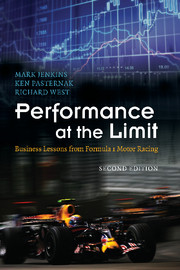Book contents
- Frontmatter
- Contents
- List of figures
- List of tables
- List of plates
- Acknowledgements
- Note on the reference system
- The Grand Prix experience
- 1 Introduction
- 2 Why Formula 1 motor racing?
- 3 The performance framework
- 4 The war for talent
- 5 Winning through teamwork
- 6 Capability through partnerships
- 7 The high-performance organisation
- 8 Integrating
- 9 Innovating
- 10 Transforming
- 11 Achieving and sustaining performance
- 12 Twelve business lessons from Formula 1 motor racing
- Appendix A Grand Prix Champions 1950–2008
- Appendix B Grand Prix Graveyard 1950–2008
- Appendix C Interview respondents
- References
- Index
- Plate section 1
- Plate section 2
8 - Integrating
effective leadership brings it all together
Published online by Cambridge University Press: 05 August 2013
- Frontmatter
- Contents
- List of figures
- List of tables
- List of plates
- Acknowledgements
- Note on the reference system
- The Grand Prix experience
- 1 Introduction
- 2 Why Formula 1 motor racing?
- 3 The performance framework
- 4 The war for talent
- 5 Winning through teamwork
- 6 Capability through partnerships
- 7 The high-performance organisation
- 8 Integrating
- 9 Innovating
- 10 Transforming
- 11 Achieving and sustaining performance
- 12 Twelve business lessons from Formula 1 motor racing
- Appendix A Grand Prix Champions 1950–2008
- Appendix B Grand Prix Graveyard 1950–2008
- Appendix C Interview respondents
- References
- Index
- Plate section 1
- Plate section 2
Summary
The man at the top is the example to the others to follow in the culture or the manner in which business should be done.
Sir Jackie Stewart, former Triple World Drivers’ Champion and former Formula 1 Team PrincipalWe have seen that Formula 1 people are passionate and competitive, and that they also work collaboratively in teams. As in all effective organisations, however, there is a need for individuals who can spur, motivate and inspire their colleagues into action. They do this by creating a harmony within the working environment that enables the separated, but inter-related functions in the business to operate in an integrated manner. This requires a form of leadership that integrates the efforts of strong-willed individuals, so that they can work cohesively towards common objectives.
Given the wide range of personalities in Formula 1, it is not surprising to find differing leadership styles. As one knows from experience the most effective managers are capable of utilising several behavioural styles in order to achieve their goals. The best managers move seamlessly between these styles and use the appropriate ones as situations warrant. It is therefore a little presumptuous to put senior managers into ‘cubbyholes’ of behaviour. But the fact is that for most managers certain dominant patterns tend to emerge regarding how they deal with their subordinates, peers and bosses within the working environment. Some managers are more low-key than others, some more hands-on than others, and some are more charismatic than others.
- Type
- Chapter
- Information
- Performance at the LimitBusiness Lessons from Formula 1 Motor Racing, pp. 134 - 151Publisher: Cambridge University PressPrint publication year: 2009



